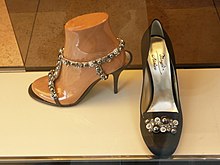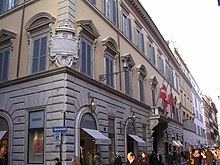Italy is one of the leading countries in fashion design, alongside others such asFrance, USA, Great Britain and Japan. Fashion has always been an important part of the country's cultural life and society, and Italians are well known for their attention to dressing-up well; "la bella figura", or good impression, remains traditional in the Italian way of living.[1]
Italian design became prominent ever since the 11th-16th centuries, when artistic development in Italy was at its peak. Cities such as Venice, Milan, Florence andVicenza started to produce luxury goods, hats, cosmetics, jewelry and rich fabrics. During the 17th-early 20th centuries, Italian fashion lost its importance and lustre, and Europe's main trendsetter became France, with the great popularity of French fashion; this is due to the luxury dresses which were designed for the courtiers ofLouis XIV.[2] However, since the 1951-53 fashion soirées held by Giovanni Battista Giorgini in Florence,[3] the "Italian school" started to compete with the French haute couture, and labels such as Ferragamo and Gucci began to contend with Chaneland Dior. In 2009, according to the Global Language Monitor, Milan, Italy's center ofdesign, was ranked the top fashion capital of the world, and Rome was ranked 4th,[4]and, despite both cities fell down places in subsequent rankings, in 2011, Florence entered as the 31st world fashion capital. Milan is generally considered to be part of the "big four" global fashion capitals, which, aside from the Italian city, consist ofNew York City, Paris and London; occasionally, the "big five" also includes Rome.[5]
Examples of major Italian fashion houses are: Gucci, Armani, Emilio Pucci,Valentino, Prada, Dolce & Gabbana, Ferragamo, Roberto Cavalli, Trussardi,Versace, Krizia, Etro, Miu Miu, Laura Biagiotti, Max Mara, Fendi, Moschino,Missoni, Bottega Veneta, Benetton and Brioni (fashion),[6] to name a few. Italy also is home to many fashion magazines, such as Grazia, Vogue Italia, Amica, Flair, Gioia.[7] Other Italian accessory and jewelry brands, such as Luxottica and Bulgari are amongst the most important in the world.
Contents[hide] |
[edit]History
Main article: History of Italian fashion
Fashion in Italy started to become the most fashionable in Europe since the 11th century, and powerful cities of the time, such as Venice,Milan, Florence, Vicenza and Rome began to produce robes, jewelry, textiles, shoes, fabrics, ornaments and elaborate dresses.[8] Italian fashion reached its peak during the Renaissance. As Italy is widely recognized as the cradle and birthplace of the Renaissance,[9][10] art,music, education, finance and philosophy flourished, and along with it, Italian fashion designs became immensely popular (especially those worn by the Medicis in Florence.[11] The fashions of Queen Catherine de' Medici of France, were considered amongst the most fashionable in Europe).
After a decline in the 17th to mid-20th century, the nation returned to being a leading nation in fashion, and Florence was Italy's fashion capital in the 50s and 60s, whilst Milan led the way in the 70s and 80s, with then-new labels, such as Versace, Armani and Dolce & Gabbana opening up and setting up their first boutiques and emporia. Until the 1970s, Italian fashion was mainly designed for rich and famous people, more or less like the French "Haute Couture". Yet, in the 1970s and 80s, Italian fashion started to concentrate on ready-to-wear clothes, such as jeans,jumpers and miniskirts. Milan became more affordable and stylish for shoppers, and Florence was deposed of its position as the Italian fashion capital.
Today, Milan and Rome are Italy's fashion capitals, and are major international centres for fashion design, competing with other cities such as Tokyo, Los Angeles, London, Paris and New York.[4]Also, other cities such as Venice, Florence, Naples, Vicenza, Bologna, Genoa and Turin are important centres. The country's main shopping districts are the Via Montenapoleone fashion district and the Galleria Vittorio Emanuele (Milan), Via dei Condotti (Rome), and Via de' Tornabuoni (Florence).
[edit]Cities
Italian fashion is dominated by Milan, Rome, and to a lesser extent, Florence, with the former two being included in the top 30 fashion capitals of the world.[12] Nonetheless, there are numerous other cities which play an important role in Italian fashion.
[edit]Milan
Main article: Fashion in Milan
In 2009, Milan was regarded as the world fashion capital, even surpassing New York, Paris, Rome andLondon.[13] Most of the major Italian fashion brands, such as Valentino, Gucci, Versace, Prada, Armani and Dolce & Gabbana (to name a few), are currently headquartered in the city. Numerous international fashion labels also operate shops in Milan, including an Abercrombie & Fitch flagship store which has become a main consumer attraction. Milan also hosts a fashion week twice a year, just like other international centres such as Paris, London, Tokyo, New York, Los Angeles and Rome. Milan's main upscale fashion district is the "quadrilatero della moda" (literally, "fashion quadrilateral"), where the city's most prestigious shopping streets (Via Montenapoleone, Via della Spiga, Via Sant'Andrea, Via Manzoni and Corso Venezia) are held. The Galleria Vittorio Emanuele II, the Piazza del Duomo, Via Dante and Corso Buenos Aires are other important shopping streets and squares. Mario Prada, founder of Prada was even born here, helping to cultivate its position as a world fashion capital.
[edit]Florence
Main article: Fashion designers of Florence
Florence being historically the first home of Italian fashion (the 1951–1953 soirées held by Giovanni Battista Giorgini are generally regarded as the birth of the Italian school[14] as opposed to French haute couture) is also home to the legendary Italian fashion establishmentSalvatore Ferragamo, notable as one of the oldest and most famous Italian fashion houses.Gucci, Prada, Roberto Cavalli, and Chanel have large offices and stores in Florence or its outskirts. Florence's main upscale shopping street is Via de' Tornabuoni, where major luxury fashion houses and jewelry labels, such as Armani, Ferragamo and Bulgari, have their elegant boutiques.
[edit]Rome
See also: Shopping areas and markets in Rome
Rome is widely recognized as a world fashion capital. Although not as important as Milan, Rome is the world's 4th most important center for fashion in the world, according to the 2009 Global Language Monitor after Milan, New York and Paris, and beating London.[15] Major luxury fashion houses and jewelry chains, such as Bulgari, Fendi,[16]Laura Biagiotti and Brioni (fashion), just to name a few, are headquartered or were founded in the city. Also, other major labels, such as Chanel, Prada, Dolce & Gabbana, Armani and Versacehave luxury boutiques in Rome, primarily along its prestigious and upscale Via dei Condotti. [17]
[edit]Other cities
Despite Milan, Rome and Florence are commonly regarded as the leading cities in Italian fashion, other cities, such as Venice, Vicenzs, Turin, Naples and Bologna, are also important centres for Italian clothing design and industry. Venice, for instance, is the home of Italian fashion house Roberta di Camerino, which was founded in 1945. The brand is famous for its handbags, and is most notably associated with the creation of the it bag, a form of handbag which is recognisable due to its status symbol.[18] Brands such as Max Mara and United Colors of Benetton, despite being major Italian brands, are not headquartered in Milan, Rome or Florence, yet, the former has its headquarters in Reggio Emilia,[19] and the latter in Ponzano Veneto.[20]
[edit]References
- ^ http://dev.prenhall.com/divisions/hss/worldreference/IT/people.html
- ^ http://www.kipar.org/baroque-costumes/costumes_male.html
- ^ http://www.gbgiorgini.it/italianfashion.htm
- ^ a b http://www.languagemonitor.com/popular-culture/fashion
- ^ http://www.languagemonitor.com/?s=fashion+capital
- ^ http://www.made-in-italy.com/fashion/fashion_houses/index.htm
- ^ http://www.made-in-italy.com/fashion/publications/index.htm
- ^ http://fashion-design-schoo-l.blogspot.com/2009/04/italian-fashion.html
- ^ http://www.ibiblio.org/wm/paint/tl/it-ren/
- ^ http://www.historyworld.net/wrldhis/PlainTextHistories.asp?historyid=ac88
- ^ http://www.renaissance-spell.com/Renaissance-Fashion.html
- ^ http://www.languagemonitor.com/fashion-capitals/new-york-regains-fashion-capital-crown-from-milan/
- ^ "The Global Language Monitor » Fashion". Languagemonitor.com. 2009-07-20. Retrieved 2010-01-03.
- ^ "the birth of italian fashion". Gbgiorgini.it. Retrieved 5 May 2009.
- ^ "The Global Language Monitor » Fashion". Languagemonitor.com. 2009-07-20. Retrieved 2009-10-17.
- ^ "Fendi". Fendi. Retrieved 2009-10-17.
- ^ "Italian Fashion Wholesale". Fendi. Retrieved 2009-10-17.
- ^ Patner, Josh (2006-02-26). "From Bags to Riches". The New York Times.
- ^ http://www.hoovers.com/company/Max_Mara_Fashion_Group_Srl/hksyhi-1.html
- ^ http://www.benettongroup.com/en/whoweare/headquarters.htm






No comments:
Post a Comment